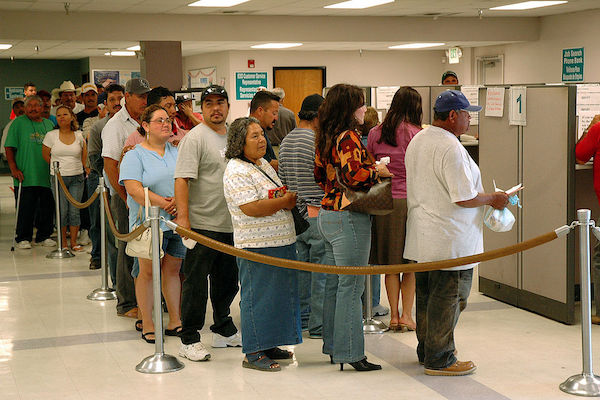At some point, not today but perhaps in the next few weeks, we will be having more conversations about getting people back to work and restoring the $21 trillion U.S. economy.
Some signs indicate the coronavirus pandemic may turn soon in the United States.
Even if the entire nation makes an all-out effort to restrict contact, coronavirus deaths will peak in the next two weeks, with patients overwhelming hospitals in most states, according to a University of Washington study.
The national response to COVID-19, particularly among doctors, nurses, law enforcement and emergency response personnel, has been inspiring. Even the military is stepping in, building field hospitals and moving other medical supplies into position for civilian use. If you want to see what personal sacrifice and risk in a time of great crisis look like, the examples are everywhere in this country.
When the time is right, we may also need an equally urgent, all-hands-on-deck response to the economy, and it will most likely be experimental and messy. Trillions in government stimulus funding will help in some quarters, but it won’t be enough to prevent huge stress, pervasive dislocation of workers and widespread failure among companies. The whole idea of returning American life to “normal” may not be the right way to put it—we don’t know what normal looks like anymore.
We need to begin figuring out our new normal without fearing accusations of “putting profits before people.” That’s nonsense. An economic collapse is not good for anyone, particularly the U.S. health care system. The American Enterprise Institute recently published a “roadmap” for addressing the pandemic in a way that respects human life, acknowledges the incredible risks this threat presents, and prudently examines ways to get America’s economic gears turning again. This is the sort of conversation we need in our political culture right now, one that doesn’t use the pandemic to score points in an election year.
The record 6.6 million workers applied for jobless claims last week, a glimpse of what we can expect in the short-term. The new numbers were released today. The Wall Street Journal noted that this mark was set “after 3.3 million sought benefits two weeks ago as the U.S. shut down parts of the economy in an effort to contain the virus.” More from the Journal:
“The speed and magnitude of the labor market’s decline is unprecedented,” said Constance Hunter, chief economist at KPMG LLP. Ms. Hunter said she expected that millions more claims will be filed in the coming weeks and projects 20 million jobs will be lost.
There are several reasons why unemployment claims are likely to remain high in the coming weeks. For one, many states haven’t fully processed all unemployment-benefit applications due to the deluge. Further, the federal rescue package signed into law last week increases the pool of workers who can tap benefits by making independent contractors and self-employed individuals eligible.
Economists at the Federal Reserve Bank of St. Louis estimated an unemployment rate of 32.1% for the second quarter of 2020. That’s equal to 53 million people, and no, that’s not a typo. “This slowdown of economic activity could inevitably lead to solvency and liquidity problems that result in workers being laid off,” the Fed said.
Bloomberg News is already reporting on how law firms are gearing up to handle distressed and failing businesses.
Even as bankruptcy lawyers themselves adjust to the new routine of working from home, many are seeing a spike in business they haven’t experienced since the September 2001 terrorist attacks and the 2008 global financial crisis.
“I think that at some level this process is going to rewrite the rules of restructuring,” Squire Patton Boggs attorney Karol Denniston said. “We’ve never lived at a time where we had to face this many factors at the same time.”
With a sudden collapse of demand in the airline, restaurant, hotel, oil and gas, and retail industries caused by widespread calls for home quarantines and social distancing, companies are desperately looking for financial strategies. The phones started ringing nonstop over the past week, much as they did in 2008, said Jessica Boelter of Sidley Austin.
I spent a lot of time in bankruptcy court when I worked as a business writer for newspapers and business publications. Bankruptcy is ugly stuff. No one emerges unscathed, whether employees, creditors or owners. Entire communities can be rocked by a major business failure, and those effects can be long lasting.
We also can’t lose sight of the broader social toll taken by this kind of deep joblessness, one that won’t be easily reversed by flipping a switch when the time comes. We’ve known for years that the country has deep pockets of despair, addiction and social atomization. Listen to the Acton Line interview I did with Tim Carney a year ago about his new book, Alienated America: While some places thrive while others collapse. Then consider these words from the show notes for that episode:
The “American Dream” is fading away in much of the country, and the problem isn’t pure economics, nor is it a case of stubborn old white men falling behind because they refuse embrace progress. Tim argues that the root cause of our problems; crumbling families, despair, political dysfunction, is the erosion of community and local, civil institutions, most especially church. The result of a secularizing country is a plague of alienation for the working class, as people struggle to build families and improve their lives without the support structure they need.
If you think nationalism and populism are currently a problem in the United States, then just watch what happens if we don’t get people working again in numbers close to what we had before the pandemic.
It bears repeating: The best poverty-reduction program is a good job. When the time is right—and not a minute before—Americans will be eager to return to their jobs, reopen their businesses and get factories humming again. But it’s time to start thinking and talking about what that looks like.

